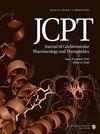暴露于电子水管会增加 C57BL/6J 小鼠患闭塞性心血管疾病的风险
IF 2.8
4区 医学
Q2 CARDIAC & CARDIOVASCULAR SYSTEMS
Journal of Cardiovascular Pharmacology and Therapeutics
Pub Date : 2024-04-09
DOI:10.1177/10742484241242702
引用次数: 0
摘要
导言:有资料表明,心血管疾病(CVD)是美国乃至全球的主要死因,而吸烟是最容易预防的死因。此外,大多数吸烟者死于血栓性疾病,而血小板在其中扮演着重要角色。为此,由于吸烟的危害已被证实,一些新型烟草产品(如电子水烟)在不同人群中越来越受欢迎,部分原因是其 "虚假 "的安全声明。为了研究电子水烟对心血管疾病的闭塞性影响,我们采用了电子水烟蒸汽/烟雾的全身小鼠暴露模型,并对 C57BL/6J 雄性小鼠(从 7 周大开始)进行为期 1 个月的暴露,对照组暴露于清洁空气中。暴露按照著名的贝鲁特方案进行,每周七次,该方案已被许多研究采用,因为它模拟了现实生活中的水烟暴露场景;具体来说,就是以 2.6 秒的抽吸持续时间和 17 秒的抽吸间隔,抽吸 171 口 530 毫升体积的电子液体。结果与清洁空气对照组相比,暴露于电子水烟的小鼠的出血时间和闭塞时间缩短,这表明存在血栓前驱表型。至于这种表型的机制,我们发现暴露于电子水烟的血小板表现出更强的激动剂触发聚集和致密颗粒分泌。此外,对血小板活化表面标志物的流式细胞术分析表明,与对照组相比,暴露于电子水管的血小板的 P 选择素和整合素 GPIIb-IIIa 活化均有所增强。最后,血小板扩散和 Akt 磷酸化在接触电子水管的小鼠中也更为明显。本文章由计算机程序翻译,如有差异,请以英文原文为准。
Exposure to Electronic Waterpipes Increases the Risk of Occlusive Cardiovascular Disease in C57BL/6J Mice
IntroductionIt is well documented that cardiovascular disease (CVD) is the leading cause of death in the US and worldwide, with smoking being the most preventable cause. Additionally, most smokers die from thrombotic-based diseases, in which platelets play a major role. To this end, because of the proven harm of smoking, several novel tobacco products such as electronic(e)-waterpipe have been gaining popularity among different sectors of the population, partly due to their “false” safety claims. While many investigators have focused on the negative health effects of traditional cigarettes and e-cigarettes on the cardiovascular system, virtually little or nothing is known about e-waterpipes, which we investigated herein.Methods and MaterialsTo investigate their occlusive CVD effects, we employed a whole-body mouse exposure model of e-waterpipe vape/smoke and exposed C57BL/6J male mice (starting at 7 weeks of age) for 1 month, with the controls exposed to clean air. Exposures took place seven times a week, according to the well-known Beirut protocol, which has been employed in many studies, as it mimics real-life waterpipe exposure scenarios; specifically, 171 puffs of 530 ml volume of the e-liquid at 2.6 s puff duration and 17 s puff interval.ResultsThe e-waterpipe exposed mice had shortened bleeding and occlusion times, when compared to the clean air controls, indicating a prothrombotic phenotype. As for the mechanism underlying this phenotype, we found that e-waterpipe exposed platelets exhibited enhanced agonist-triggered aggregation and dense granule secretion. Also, flow cytometry analysis of surface markers of platelet activation showed that both P-selectin and integrin GPIIb-IIIa activation were enhanced in the e-waterpipe exposed platelets, relative to the controls. Finally, platelet spreading and Akt phosphorylation were also more pronounced in the exposed mice.ConclusionWe document that e-waterpipe exposure does exert untoward effects in the context of thrombosis-based CVD, in part, via promoting platelet hyperreactivity.
求助全文
通过发布文献求助,成功后即可免费获取论文全文。
去求助
来源期刊
CiteScore
6.00
自引率
0.00%
发文量
33
审稿时长
6-12 weeks
期刊介绍:
Journal of Cardiovascular Pharmacology and Therapeutics (JCPT) is a peer-reviewed journal that publishes original basic human studies, animal studies, and bench research with potential clinical application to cardiovascular pharmacology and therapeutics. Experimental studies focus on translational research. This journal is a member of the Committee on Publication Ethics (COPE).

 求助内容:
求助内容: 应助结果提醒方式:
应助结果提醒方式:


